The Ultimate Guide to Container Gardening
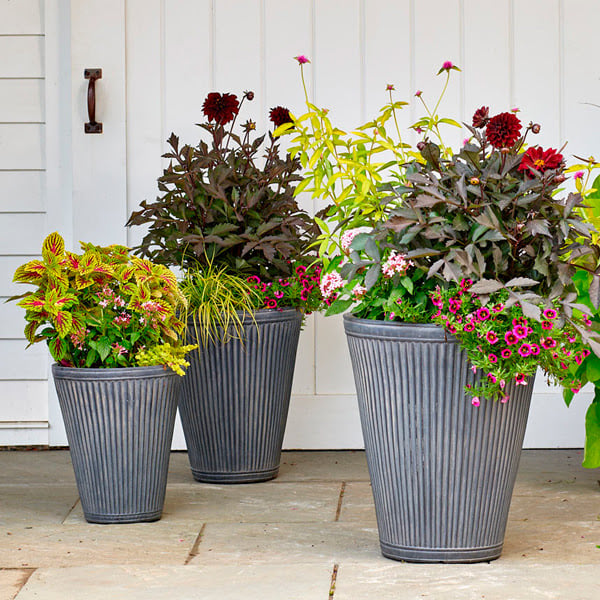
If you’re interested in starting or expanding your garden with potted plants, window boxes, or hanging baskets, we can help. Our guide to container gardening will help you design, plan, plant, and care for your potted plants with confidence.
What is Container Gardening?
As the name suggests, container gardening is the process of growing plants in containers, rather than directly in the ground. There are many types of containers, such as ceramic pots, decorative containers, hanging baskets, and window boxes. Many plants can be grown in containers, including certain types of flowers, shrubs, vegetables, fruits, herbs, and trees.
Why Container Gardening?
There are many different reasons you might choose to grow plants in containers. Anyone who has attempted gardening in small spaces appreciates the flexibility that pots and planters provide. Urban gardens are an especially popular trend where city-dwellers utilize raised beds on rooftops, hanging baskets in bedrooms, and planters on patios to grow a variety of annuals, perennials, vegetables, herbs, and even small shrubs.
Even individuals with ample outdoor space turn to container gardening for its many benefits and advantages. First and foremost is aesthetics: most porches and patios look better with a few strategically placed planters filled with eye-catching blooms and interesting foliage.
Another benefit of containers is the convenience they lend. Some people prefer to grow vegetables and herbs in pots and raised beds where it is easier to control growing conditions. Containers enable you to grow plants that wouldn’t otherwise survive outdoors in your climate, offering greater selection. If deer are a concern, placing plants on elevated porches or in hanging pots where deer can’t easily reach them can provide a simple solution.
Container Gardening Tips for Success
While container gardening offers many advantages, please be aware of a few related plant care issues. Plants in containers are generally more sensitive to temperature fluctuations because their roots have less insulation than in-ground plants. Plants tend to require more frequent watering, especially when temperatures are high, as moisture quickly evaporates from their soil. Many potted plants require regular fertilization since nutrients are leached from the soil each time they are watered. Some plants grown in containers may require occasional re-potting as they grow to avoid becoming rootbound. Any time you adopt a new plant, taking time to review care instructions will help you understand its specific needs and set you up for success.
Getting Started
What Supplies Do I Need for Container Gardening?
The only supplies you absolutely need to start a container garden are soil, seeds or plants, and a container to grow them in. You may also want to invest in basic garden tools, such as a small trowel, cultivator, gloves, and shears, for easier potting, repotting, and pruning. Container gardens typically have higher than average water requirements, so consider investing in a watering pail, sprinkler, and/or drip irrigation system to keep your plants hydrated.
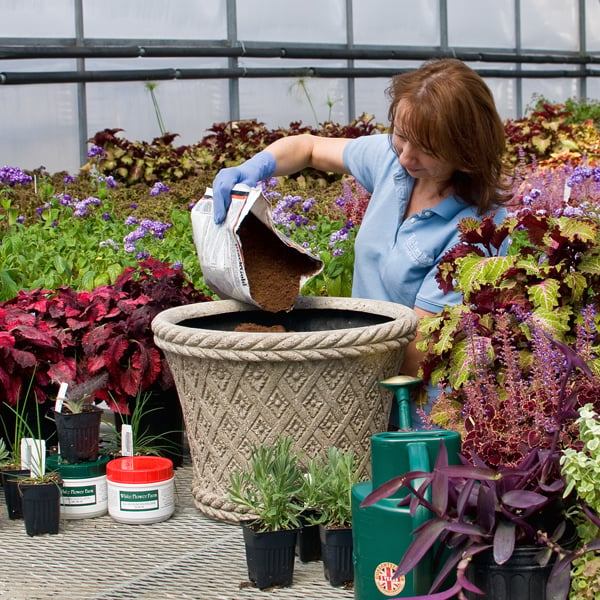
How to Prepare Soil for Container Gardening?
Container gardens have special soil requirements to keep plants healthy and happy. Many gardeners purchase special potting mixes, which we offer and are available at most garden supply stores. These mixes are specially designed for container gardening and help ensure growing success. If you happen to have your own compost pile (or other composting system), it’s always helpful to add rich compost to any potting mix. If you don’t currently have a compost pile, consider creating one so you have ready access to compost for all your planting needs.
What Do You Put in the Bottom of a Planter Without Drainage Holes?
Many plants require well-drained soil to grow and thrive, and potted plants are no exception. Containers should have adequate drainage to prevent root rot and keep plants healthy. Planters must have drainage holes in the bottom to enable excess water to run out; if you are keeping your plants indoors or on a patio, place a saucer beneath the container to catch excess water. Outdoor containers placed directly on soil will not drain as well; consider elevating outdoor plants on mulch, stone, or wood to help facilitate excess water running out.
What Do You Put in the Bottom of Large Plant Containers?
Some gardeners like the look of large containers for decorative purposes, but it can be expensive to fill the entire pot with quality soil and makes planters extremely heavy. Save money and keep planters lighter by using filler at the bottom of the pot. Lightweight fillers include recycled plastic water bottles, styrofoam packing materials, aluminum cans, mulch, and pine straw. If you do not plan to move your pot and prefer materials to make the pot sturdier, heavy filler options include broken ceramic pots, bricks, stones, and cinder blocks. Whichever filler you choose, fill the pot about one-third full before adding your soil mix and plants. Some gardeners like to include a layer of landscape fabric between the fillers and potting mix to keep soil from slipping down and prevent filler materials from leaching into plants.
How to Plan A Container Garden
With so many different plants and container styles to choose from, planning your container garden can seem daunting. Follow these simple steps to plan your container garden:
- Select a location. We recommend starting with location to help narrow down your options for plants and container types. How much light does the space receive? How much space do you have for your container? These are all important factors that will impact your container garden choices.
- Choose a container. Consider factors such as appearance, cost, and size when selecting your container. Some popular options include:
- Clay (terra cotta) pots. These classic options look great with most décor, and some clay pots have glazes or decorative designs to add to their visual appeal. Terra cotta pots may be fairly delicate and prone to chipping or cracking, especially in colder temperatures. Happily, our Whichford Pottery comes with a 10-year- guarantee. Note that plants in terra cotta pots—which are porous—will need more frequent watering than those in other types of containers.
- Stone or concrete pots. These heavy-duty containers are extremely durable, but depending on their composition, their weight makes them difficult to reposition, especially when they are full of soil. Consider our lightweight Lavastone planters as an alternative.
- Wood barrels. Wood provides a rustic, natural feel to container gardens. For best results, choose a container made from hardy wood such as cedar, which should stand up to the elements for many years.
- Plastic or Fiberglass. Pots made from synthetic material are lightweight and available in a variety of styles to match your décor. Some plastic pots feature self-watering systems for easier plant maintenance. Plastic and fiberglass containers can typically withstand freezing temperatures, but they will need to be replaced when they eventually crack or chip.
- DIY container. Just about any bucket or other receptacle can become a container garden. Some options include repurposing bird baths, watering pails, metal buckets, rope baskets, and more. If your repurposed container does not have drainage, you’ll have to add drainage holes to avoid root rot.
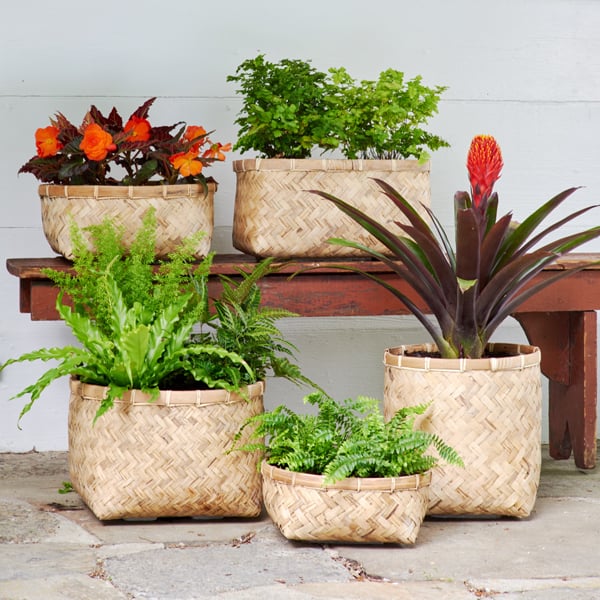
- Decide what you want to plant. Most plants fall into one of two main categories: annuals and perennials. Annual plants are planted in the spring and generally die with the first in the fall, so they need to be re-planted each year. By contrast, perennial plants go dormant in the fall and re-emerge the following spring. To help your perennials survive cold winter temperatures, they should be transplanted into the ground to overwinter, and then dug up and replanted in the container, if desired, the following spring. While some perennials are suitable for container gardening, most people prefer annuals to create exceptional potted plantings for patios, decks, terraces, porches, and front entries. Annuals work hard for your container garden, since many provide either a continuous show of colorful blooms or attractive foliage; some even offer both. There are annuals that will suit virtually any color scheme, gardening style, and setting. Annuals offer instant gratification and their display lasts all summer.
- Select your plant or plants. Choose plants based on their light requirements and individual preferences. Avoid overcrowding by limiting the number of plants you place in each container. Plant care instructions on spacing vary, but generally, annuals should be planted 12” apart. Some of the best plants for container gardening include:
- Impatiens
- Coleus
- Geranium
- Angelonia
- Begonia
- Starflower
- Petunia
- Violet
- Zinnia
- Fountain Grass
Many gardeners follow the “thriller, filler, and spiller” formula for selecting container plant combinations. The “thriller” is a tall plant that will serve as a focal point, the “spiller” is a trailing plant that spills over the edge of the container, and the “filler” is a medium-height plant that fills in the gaps with foliage. Purchase one of our annual collections with expertly selected plant combinations, or design your own. Some of our favorite plant combination ideas for container gardens include:
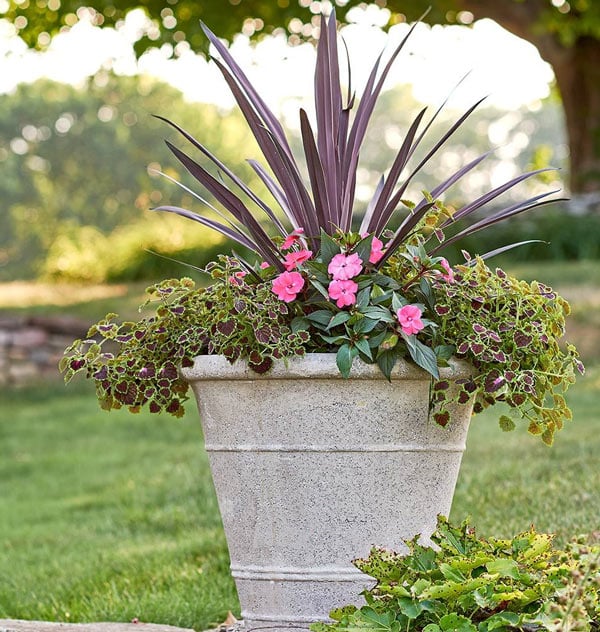
- Cabbage Palm, Coleus, and Impatiens
- Petunias and Fountain Grass
- Coleus, Impatiens, and Ornamental Grass
- Agastache, Verbena, and Coleus
- Mandevilla, Spurge, and Plectranthus
- Dwarf Papyrus, Lantana, and Creeping Zinnia,
As you plan your own container collections, keep a few design tips in mind. Whatever you do, try to have fun with the process and remember that it's easy to rearrange designs with annuals. A harmonious color scheme features plants with similar hues, such as pastels or hot colors. Hues that are close together on the color wheel will generally produce a pleasing harmony. Contrasting colors also can work well together, especially if they are opposites on the color wheel, such as yellow and purple, blue and orange, or red and green. Lighter and darker versions of each color will help to tie the scheme together, adding harmony to the dynamism of different colors. When in doubt, keep it simple.
Planting Your Container Garden
Begin by adding moist potting mix to the container until the container is about three-quarters full. Next, set the plants on the mix, spacing them much more closely than you would when planting them in the ground. Put the tallest plants in the center, surround them with shorter, mounding plants, and put trailing plants along the edge. When you are pleased with your arrangement, add potting mix to bring the level to within 1” of the container's rim and firm lightly. Finally, water thoroughly.
Container Vegetable Gardening
What Kind of Soil to Use for Container Vegetable Gardens
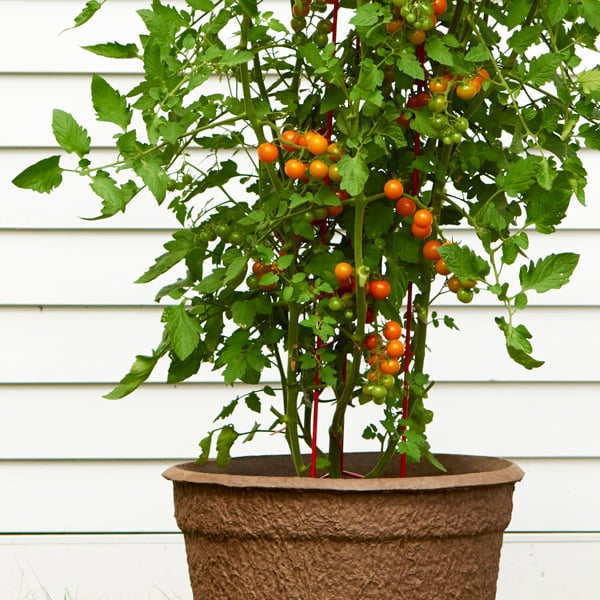
As is the case with any potted plants, you can purchase a special vegetable potting mix from your garden supply store or make your own. If you are growing vegetables in containers, opt for a soil mixture that contains vermiculite to help prevent it from drying out between waterings as vegetables are highly susceptible to drought and moisture fluctuations. Vegetables, in particular, benefit from the addition of rich compost to the potting mix.
How to Grow a Container Vegetable Garden
Many fruits, vegetables, and herbs are ideal for growing in pots and planters. Consider how much space your plants need when choosing which vegetables to grow in containers. Some crops, such as squash, require a lot of space to sprawl, and many demand deep containers to accommodate their deep roots. Almost all require full sun. Some of the best choices for container vegetable and fruit gardening include:
- Cucumbers
- Strawberries
- Tomatoes
- Kale
- Hot Peppers
- Squash
- Blueberries
Choose a container based on your plant’s needs. Some plants require cages or ladders to support the weight of their vegetables. Some climbing vine types need a trellis. Planter boxes for vegetables should be at least 12-18” deep, though some vegetables, like potatoes and carrots, may require deeper beds.
Maximize your garden space by planting multiple companion plants in the same containers. By combining tall plants with vining or trailing plants, you can get more produce from your pots. Vegetables from the same family should not be grown together because they will compete for the same nutrients.
Common vegetable pairings include:
- Beans, Carrots, and Squash
- Beans and Eggplant
- Spinach and Chard
Vegetable combinations to avoid include:
- Carrots and Fennel
- Beans and Onions
- Tomatoes and Potatoes
- Cucumbers and Squash
How to Plant An Herb Garden In A Container
Herbs are ideal container plants as you can grow them right in your kitchen or patio for easy access while cooking. Most herbs can be grown in containers, though some favorites are:
- Basil
- Oregano
- Parsley
- Rosemary
- Thyme
- Tarragon
Herbs can be grown solo, in groups, mixed in containers with vegetables (some chefs say tomatoes grown with basil take on their flavor), or in decorative pots with other annuals or perennials. As with all containers, make sure all plants that share a space have similar needs. Some herbs, such as mint, are invasive and should be grown alone to avoid crowding out other plants.
Container Gardening Tips
Even if you follow all the best practices in choosing your plants, soil, and containers, you may have some plants that thrive while others struggle to survive. A few helpful container gardening tips include:
- Plants that are native to your region or native to regions with similar climates to where you live will generally require less maintenance and be easier to care for.
- Early morning and sunset are the best times to water plants, especially during the heat of summer.
- Large, heavy planters can be placed on small platforms with wheels for easier moving.
- Mulching containers can help retain moisture in the summer and protect plants from cold in the winter.
- Remember to fertilize potted plants regularly to replace nutrients that are washed out each time you water.
How to Keep Wildlife Out of Your Container Garden
If squirrels, birds, bunnies, and deer are looking at your potted plants like their own personal salad bar, there are a few simple ways to deter them:
- Choose deer-resistant plants and bulbs.
- Sprays and Powders. Make an all-natural garlic spray with water, vinegar, and chopped garlic or sprinkle cayenne pepper powder around plants to help keep wildlife at bay. Some garden supply stores also sell species-specific deterrent sprays.
- Windchimes and Sprinklers. Most garden grazers are prey species, so they are easily deterred by loud noises. Strategically-placed windchimes can startle deer and bunnies, while motion-activated sprinklers will keep most wildlife away from your plants.
- Physical Barriers. Nets and cages that cover containers can keep birds and squirrels from digging or eating seeds. Small fences will keep bunnies out of your plants, while deer are only deterred by fences over six feet high. If you have a plant that your neighborhood wildlife seems to enjoy as much as you do, consider bringing the plant inside at night for protection.
How to Water Container Garden While on Vacation
Your vacation doesn’t have to be the end for your beloved plants. There are various ways to ensure your plants continue to receive water while you’re away. A drip irrigation system with an automatic timer can keep your plants perfectly watered, regardless of whether you’re home or away. If you travel often or just prefer a low-maintenance garden, it may be worthwhile to invest in a drip irrigation system. Similarly, consider using sprinklers with a self-timer to water containers while you’re away. This may require you to move your containers to a single area temporarily, but can be a great way to keep plants healthy while you’re gone.
Watering globes are another easy and attractive way to automatically water plants. These are especially useful for indoor plants where hoses and sprinklers are not feasible options. They are available in most garden supply stores and can keep most potted plants perfectly watered for one to two weeks. You can make your own aqua globes with recycled plastic bottles. Simply poke a small hole in the bottle cap, fill the bottle with water, replace the cap, and submerge the bottle, cap-side down, in your container’s soil. Depending on the size of your containers, the size of the bottle, the length of your vacation, and the temperature, you may need more than one water globe or water bottle in each container.
Preparing Container Gardens for Winter
In mild-winter climates—Zone 8 (10°F) and warmer—hardy plants can generally be left outdoors in containers with little risk to the plants or pots.
In climates where winter temperatures drop well below freezing, containers should be dismantled in fall. Bring tender plants indoors or toss them on the compost heap; plant hardy bulbs, perennials, and shrubs in the ground. Most containers should be emptied and stored under cover where they will not freeze; plastic and fiberglass pots, along with our Whichford and Lavastone planters, can be left outside over winter.


